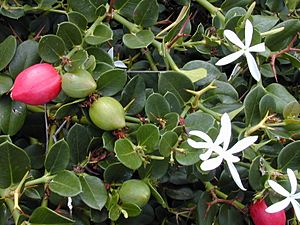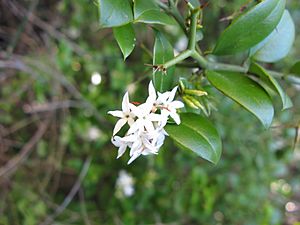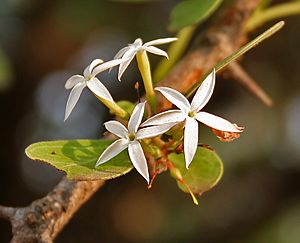Carissa facts for kids
Quick facts for kids Carissa |
|
|---|---|
 |
|
| Natal Plum (C. macrocarpa) | |
| Scientific classification |
|
| Kingdom: | Plantae |
| Clade: | Tracheophytes |
| Clade: | Angiosperms |
| Clade: | Eudicots |
| Clade: | Asterids |
| Order: | Gentianales |
| Family: | Apocynaceae |
| Tribe: | Carisseae |
| Genus: | Carissa L. |
| Synonyms | |
|
|
Carissa is a group of plants that are either shrubs (like big bushes) or small trees. You can find them naturally in warm, sunny places in Africa, Australia, and Asia. For a long time, people thought there were about 100 different kinds of Carissa plants. But now, scientists have grouped many of them together or moved them to other plant families.
Contents
What are Carissa Plants Like?
Different types of Carissa grow as shrubs or small trees. They can be anywhere from 2 to 10 meters (about 6 to 33 feet) tall. These plants have smooth, sharp thorns. These aren't just sharp bits; they are actually changed branches! The thorns can be simple, like on the Carissa spinarum. Some have thorns that split into two, like Carissa bispinosa. Others, like Carissa macrocarpa, have thorns that branch out even more.
The leaves of Carissa plants are a shiny, waxy green. They are smooth and usually shaped like an oval or a spear. They are about 2 to 8 centimeters (about 1 to 3 inches) long. The leaves are often thick and feel leathery. In warm places, some Carissa plants can have flowers almost all year! The flowers are small, about 1 to 5 centimeters (0.4 to 2 inches) wide. They have five white or pink petals. These flowers can grow alone or in pretty clusters. Some Carissa flowers smell a bit like Gardenia flowers, which makes them popular garden plants.
The fruit of the Carissa plant looks like a small plum. It's shaped a bit like a rugby ball. The color of the fruit changes depending on the type of Carissa. Some turn red when they are ripe, while others become a shiny purple-black. They are usually 1.5 to 6 centimeters (0.6 to 2.4 inches) long. Inside, you'll find 1 to 4 flat brown seeds, but some types can have up to 16 seeds.
Tasty or Not? All About Carissa Fruit
The fruit of the Carissa plant is an oblong berry with many small seeds. It's important to know that the green, unripe fruit can be poisonous. But when the fruit is ripe, it is safe to eat! It might taste a bit tart, but some types have a fruity flavor that reminds people of strawberry or apple. Carissa fruits are full of good things like Vitamin C, calcium, magnesium, and phosphorus. The fruit of C. macrocarpa is especially liked. People eat it fresh or use it to make jelly. Many birds also enjoy eating Carissa fruit, which helps spread the seeds around.
Carissa carandas is a type of Carissa grown in several countries in Asia. Its fruit is used in cooking and in traditional medicine.
Growing Carissa Plants
Carissa plants are great for gardening. They can be shaped into interesting designs (called topiary). They also make strong, thick, thorny, and beautiful flowering hedges. Some types of Carissa spread out and can be used as ground covers.
You can grow Carissa plants from seeds or from cuttings (small pieces of the plant). They can handle a little bit of frost, but they prefer warmer weather.
Different Kinds of Carissa
Here are some of the recognized types of Carissa plants:
- Carissa bispinosa - Found across East and South Africa.
- Carissa boiviniana - Found in Madagascar.
- Carissa carandas - Found in India, Bangladesh, and other parts of Asia. It has also spread to places like China and the West Indies.
- Carissa haematocarpa - Found in Namibia and South Africa.
- Carissa macrocarpa - Found from Kenya south to South Africa. It has also spread to places like Hawaii, Florida, and Mexico.
- Carissa pichoniana - Found in Madagascar.
- Carissa spinarum - Found across Africa, the Arabian Peninsula, India, Australia, and other regions.
- Carissa tetramera - Found in East and South Africa.
See also
 In Spanish: Carissa para niños
In Spanish: Carissa para niños



